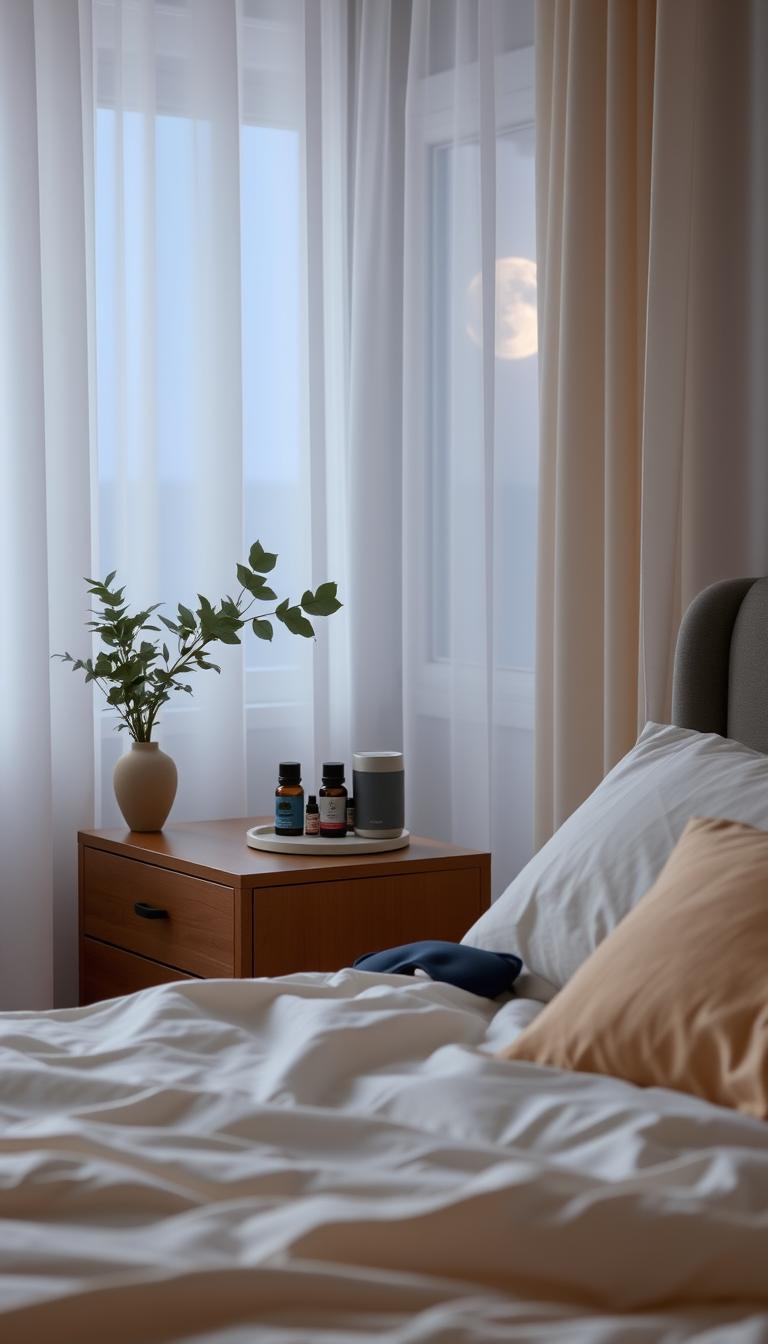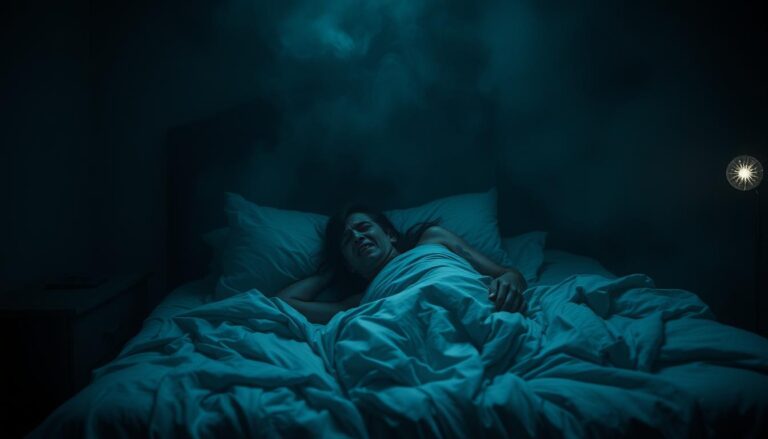
Did you know 25 million adults in the U.S. have obstructive sleep apnea (OSA)? This condition makes you stop breathing hundreds of times each night. It leaves you gasping for air and tired all day. Even worse, half of people stop using CPAP machines within a month, risking serious health problems like heart failure.
But what if just flipping onto your side could help? Research shows side-sleeping can cut apnea episodes by up to 50%. This makes it a simple yet powerful tool for better sleep.
Obstructive sleep apnea happens when your throat muscles relax too much, blocking airflow. Your sleeping position affects this a lot. Lying on your back doubles breathing pauses compared to side-sleeping.
While CPAP machines are key for severe cases, those with mild to moderate OSA might find relief in positional therapy. This guide will show how changing your sleep posture can improve oxygen flow. It can also reduce snoring and lower your risk of heart disease. Let’s explore the science behind the best sleeping positions for sleep apnea relief and how they can change your nights.
Key Takeaways
- 25 million Americans have OSA, with back-sleeping doubling breathing pauses.
- Side-sleeping reduces apnea episodes by up to 50%, making it a top sleep apnea sleeping position.
- Half of CPAP users quit early, highlighting the need for alternatives like positional therapy.
- Elevating your upper body 30 degrees or using side-sleeping techniques can improve airflow naturally.
- Lifestyle changes like weight loss and avoiding alcohol boost the effectiveness of sleep position adjustments.
Understanding How Sleeping Positions Impact Sleep Apnea
Sleep positions are key in managing sleep apnea. The way you sleep affects your breathing. For those with obstructive sleep apnea (OSA), some positions help open airways while others block them. Let’s look at the science behind this.
The Relationship Between Body Position and Airway Obstruction
Gravity affects how open your airway is. Sleeping on your back can narrow breathing passages. Side sleeping, however, keeps airways open, reducing snoring and mild apnea symptoms. Here’s how positions compare:
| Position | Airway Impact | Recommended? |
|---|---|---|
| Back (supine) | Risk of tissue collapse | No |
| Side Sleeping | Maintains airway space | Yes |
| Stomach | Neck strain and possible obstruction | No |
Why Your Current Position May Worsen Symptoms
Sleeping on your back can make symptoms worse. This position can block airways, causing breathing pauses. Stomach sleeping also strains the neck and presses on the diaphragm, making breathing harder.
Even side sleeping preferences matter. Those with GERD might find left-side sleeping better than right.
The Scientific Evidence Behind Positional Therapy
A 2020 study in Journal of Clinical Sleep Medicine found positional therapy reduced apnea episodes by 50% in mild cases.
Studies show that changing sleep positions can help many with sleep apnea. Mild OSA patients often see better results by sleeping on their side. But, severe cases might still need CPAP machines.
Using the best sleep positions can also help with GERD and neck pain for some.
Side Sleeping: The Best Sleeping Positions for Sleep Apnea Relief
Sleeping positions are key for managing sleep apnea. Side sleeping is one of the effective sleep positions for sleep apnea relief. It helps keep the airway open, reducing breathing pauses. Many find it helps with snoring and improves sleep quality.
Left vs. right side: Research suggests sleeping on your right side may help with OSA symptoms. This is because of how heart blood flows. The left side is better for those with acid reflux, as it helps with digestion. Try both sides to see what works best for you.
Start with your knees for proper alignment. Use a pillow between them to keep hips and spine aligned. A body pillow hugged to your chest or behind your back adds support. Elevate your head with a wedge pillow to keep the throat open. Here’s how to set up:
- Use a pillow under your head angled 30 degrees to prevent neck strain.
- Position a firm pillow between your legs to maintain hip alignment.
- Try a full-body pillow to cradle your torso and reduce midsection pressure.

Discomfort like shoulder numbness or hip stiffness? A memory foam pillow under your arm can help. Swap stiff pillows for softer ones to ease hips. If your arms fall asleep, avoid lying on them—place hands above your head instead. Adjust pillows nightly until you find your sleeping positions for better sleep with sleep apnea.
Small tweaks can make side sleeping a habit. Use a firm mattress if you wake up with aches. Experiment to find the setup that works best for your body.
Elevated Sleeping Positions and Their Benefits
Raising your upper body while sleeping can help. It reduces airway blockage and improves breathing. Proper sleeping positions for sleep apnea relief often include elevating the head and shoulders. This keeps the throat muscles active and reduces breathing interruptions caused by gravity.
- Use a 30- to 45-degree incline with a wedge pillow or adjustable bed frame.
- Position your head so your chin stays slightly lifted to avoid jaw relaxation.
- Ensure your spine stays aligned to prevent neck strain.
| Method | Benefits | Tip |
|---|---|---|
| Wedge Pillow | Supports airflow and reduces snoring | Choose a 6-12 inch height |
| Adjustable Bed | Customizable angles for comfort | Set to 30° for moderate elevation |
| Stacked Pillows | Budget-friendly option | Avoid stacking more than 3 pillows |
If you sleep on your back, a 30° incline can help. Your healthcare provider might adjust your CPAP pressure to match this position. Elevatingion also aids those with GERD or heart issues by reducing stomach acid flow and chest pressure.
Combining elevation with side sleeping may offer best sleeping positions for sleep apnea relief. Experiment with angles to find comfort while maintaining airflow. Prioritize alignment to avoid morning stiffness.
Positions to Avoid if You Have Sleep Apnea
Choosing the right sleep apnea sleeping positions is key. But, it’s also important to avoid certain postures. These can make breathing problems worse and increase health risks.
Why Sleeping on Your Back Can Worsen Symptoms
Back sleeping (supine position) is a big problem for sleep apnea. Gravity makes your tongue and throat tissues fall back. This narrows your airway.
Studies show up to 80% of people with positional sleep apnea have fewer breathing stops when not on their back. Each stop can last up to 10 seconds. This can harm your heart or cut off oxygen.
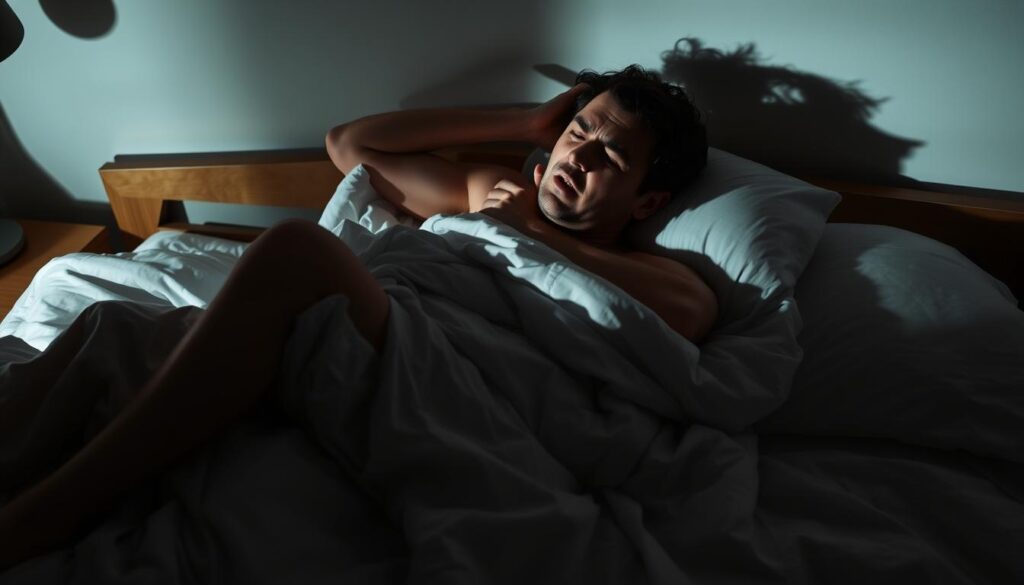
Addressing Stomach Sleeping Concerns
Some think stomach sleeping keeps the airway open. But, it can hurt your neck and spine. Many wake up with neck pain from trying to breathe.
Research shows 17% of people sleep this way. But, it often disrupts sleep cycles. The best sleep positions for sleep apnea are side-sleeping alternatives.
- Back Position: Increases airway blockage risks by 300% compared to side sleeping.
- Stomach Position: Linked to 40% higher reports of nighttime discomfort and muscle tension.
Switching to side sleeping reduces strain and keeps your airway open. Use pillows to keep you aligned for lasting relief.
Helpful Sleep Accessories for Optimal Positioning
Choosing the right accessories can make a big difference in maintaining sleep positions to alleviate sleep apnea. Whether you’re a side sleeper or adjusting your mattress, these tools help keep your airway open and your body aligned.
Specialized Pillows for Better Support
Start with pillows tailored to your sleep style. Effective sleep positions for sleep apnea relief often require specific support. For side sleepers, thick pillows keep your neck aligned. Back sleepers need thinner options, while stomach sleepers opt for even thinner material.
A CPAP pillow with indents for masks can reduce leaks and discomfort. “These pillows are specifically designed to accommodate CPAP masks,” says sleep therapist Dr. Lisa Chen. Consider the Tempur-Pedic Cervical Pillow or the B8 Smart Pillow for targeted neck support.
Body Alignment Tools and Wedges
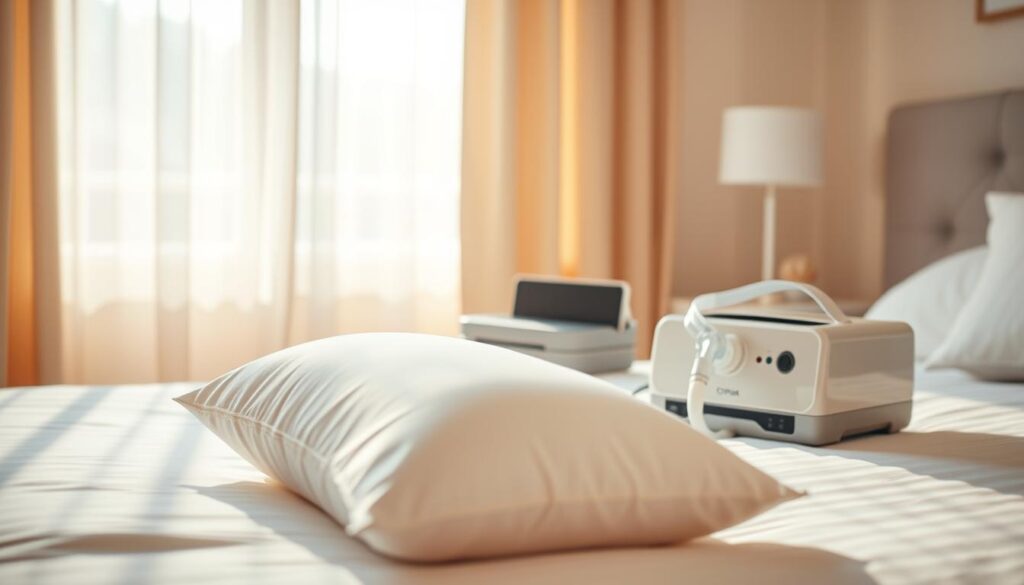
Wedges and wedges placed under your mattress can elevate your upper body, reducing airway blockage. The Luma Adjustable Bed Wedge or a memory foam body bolster helps keep your spine straight. For severe cases, a mattress like the Sleep Number c2 Smart Bed adjusts firmness to prevent rolling onto your back.
Replace your mattress every 5-8 years—sagging beds worsen alignment.
Position Trainers and Smart Devices
- Position trainers like the Sleepace SomniFlo Smart Pillow vibrate when you roll onto your back, guiding you back to your side.
- Smart devices track your sleep position and alert you via an app, like the Withings Sleep Analyzer.
- Wearable bands, such as the Sen Sleep Shirt, monitor breathing and position shifts to improve overnight comfort.
Pair these tools with a hypoallergenic mattress protector to reduce allergens that disrupt sleep. Small changes to your setup can lead to bigger improvements in breathing and rest.
How to Transition to New Sleeping Positions Successfully
Changing sleeping positions for better sleep with sleep apnea takes time. Start small by placing pillows behind your back to help you sleep on your side. Try to stay consistent for 2–4 weeks. The National Institutes of Health says sleeping on your side can help keep your airways open.
“Try your best to keep the same bedtime and wake time every day of the week.” — Dr. Knobbe
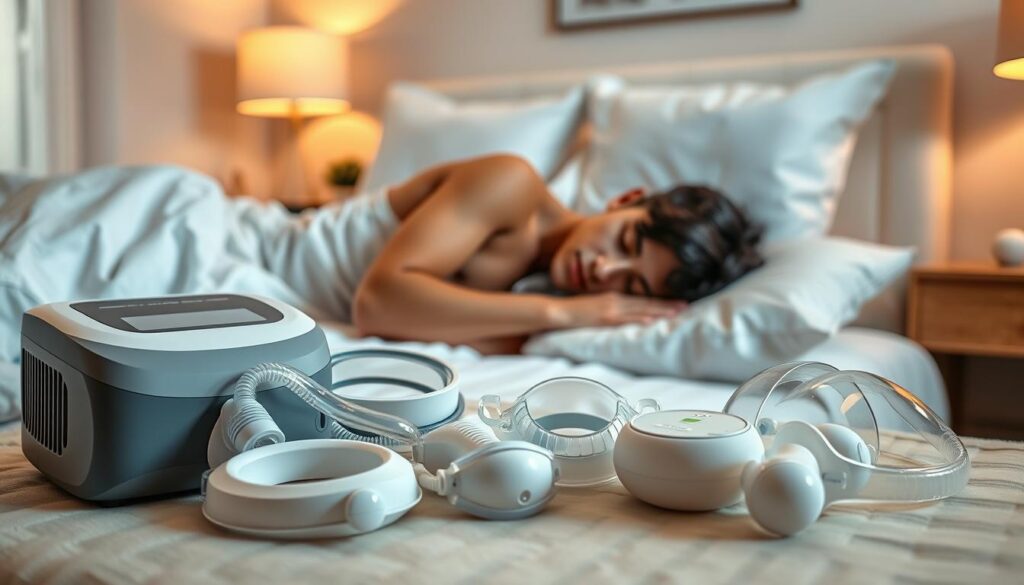
- Start with 30-minute sessions in the new position before full nights.
- Use pillows between knees or under hips to ease pressure points.
- Track progress with a journal to spot patterns and adjust habits.
| Issue | Solution |
|---|---|
| Shoulder pain | Place a pillow between knees or use a body pillow for support. |
| Rolling onto back | Wear a sleep apnea and proper sleeping positions reminder shirt or use a tennis ball sewn on pajama backs. |
| Difficulty staying elevated | Adjust wedge pillows gradually to desired angles. |
Memory foam pillows or smart beds can help. Celebrate small wins, like staying on your side for an extra hour. Stay patient. Your body adapts best with consistent practice.
Special Considerations for Different Types of Sleep Apnea
Choosing the optimal sleep positions for sleep apnea depends on your diagnosis. Obstructive sleep apnea (OSA) often improves with positional therapy. Central sleep apnea needs different strategies. Here’s how to tailor your approach:
Positional Therapy for Obstructive Sleep Apnea
For OSA, sleeping on your side is best. It keeps airways open. Studies show 50% of mild OSA cases are positional. Positional therapy reduces the apnea-hypopnea index (AHI) by 54.1%.
Meta-analysis found positional therapy cut AHI by 54.1%, improving oxygen levels by 3.3%.
Devices like chest belts or wedges help. They reduce back-sleeping, lowering AHI by up to 79%.
Central Sleep Apnea and Sleeping Positions
Central sleep apnea comes from brain signaling issues. Positional changes are less effective. Treatments like adaptive servo-ventilation (ASV) machines are better. Always check with a specialist to rule out OSA overlap.
Combined Approaches for Severe Cases
Severe OSA may need best sleeping positions for sleep apnea relief and CPAP or oral appliances. A study found CPAP compliance averaged 4.9 hours/night. Positional therapy added 2.5 hours. Combining methods can lower AHI by 36% and improve sleep efficiency.
| Type | Key Factors | Best Strategies |
|---|---|---|
| Obstructive Sleep Apnea (OSA) | Airway blockage from gravity | Sleep on side, use positional devices |
| Central Sleep Apnea | Brain signal irregularities | Medical devices + positional awareness |
| Combined Sleep Apnea | Mix of OSA and central causes | CPAP + positional therapy + lifestyle changes |
Always work with a doctor to tailor your plan. Positional therapy alone helps 22 million Americans. But complex cases need layered solutions.
Conclusion: Creating Your Personalized Sleep Position Strategy
Your journey to better sleep starts with finding the right sleep positions. Begin by talking to a healthcare provider. They can confirm your sleep apnea type and severity.
Try side sleeping—left for reflux relief or pregnancy, right for heart health. Or try elevating your head with pillows. These positions can open your airway and reduce nighttime interruptions.
Track which positions work best and adjust accessories like wedges. This will support your chosen posture.
Combine these changes with lifestyle tweaks. Losing 10–15 pounds may ease breathing. Also, 30 minutes of daily exercise boosts overall health.
Remember, sleep positions are just one part of your plan. Pair them with treatments like CPAP or oral devices if advised. Over time, small adjustments can lead to noticeable improvements.
With patience and consistency, you can create a routine. This routine will help you breathe easier and wake up refreshed.






